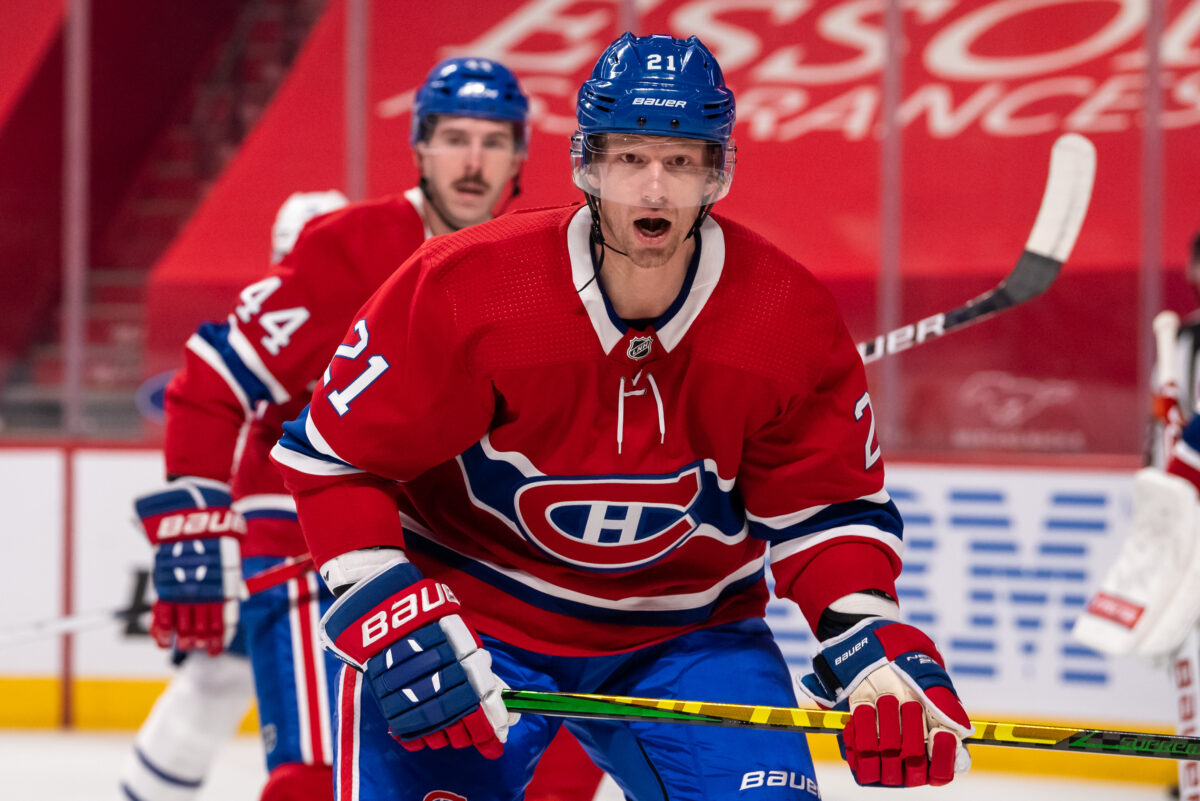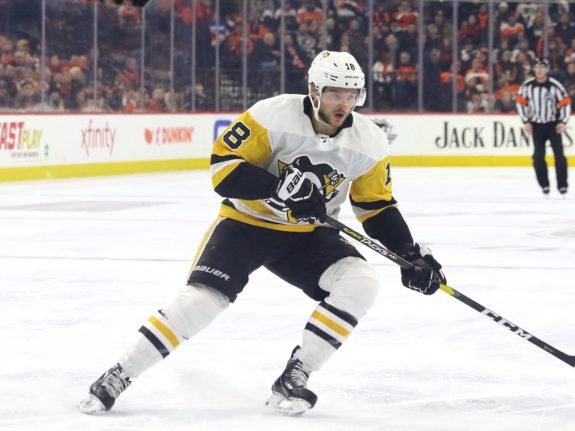Rookie camps are getting underway this week, officially marking an end to the brief reprieve offered by the summer after an offseason which burst forth in a whirlwind of commotion, as countless stars and scrubs swapped jerseys in recent months. Like any hotly-contested game of musical chairs, many find themselves without a contract and are now stranded on an island of uncertainty.
A cluster of diminished assets will anxiously litter the sidelines, as in just a few short weeks the big clubs will hit the ice with lineup mainstays, as well as those on the margins battling for prospective ice-time and plum gigs on special teams. Plenty of possible steals linger, and here are three potential bargains for the Colorado Avalanche on a Professional Tryout (PTO) contract.
Eric Staal – Center
Fresh off of an appearance in the Stanley Cup Final with the Montreal Canadiens, the revered Eric Staal has not yet parlayed a decent playoff showing into a contract for next season, still left unsigned with only 26 days remaining until opening night. Most teams could find room in the lineup to squeeze in an experienced Cup-winning pivot, and the Avalanche are no exception.

Even in his twilight years, Staal functions as a steady hand down the middle, ensuring that his defensive responsibilities are accounted for before going big-game hunting for offence. He managed to maintain positive possession numbers while featuring prominently for the forsaken Buffalo Sabres early in the season, hovering around 49-50% in Corsi-for percentage (CF%). He then flourished with the Canadiens where he was a guiding presence on a young team venturing into unknown waters, scoring eight points in 21 playoff games.
Staal is serviceable in the face-off dot, with his career rate on the draw just over 49%, not particularly strong, but also not a proportion that will become a frustrating burden. In a pinch, he can occasionally relieve one of Colorado’s other centers and not burn the team in the case of a faceoff loss, given his mental awareness has not declined as sharply as his physical abilities.
You may also like:
- Avalanche Can Win 2025 Stanley Cup with New Goalie Tandem
- 3 Takeaways From the Avalanche’s 3-1 Loss to the Canucks
- Sherwood’s First-Career Hat Trick Leads Canucks to 3-1 Win Over Avalanche
- Projected Lineups for the Avalanche vs Canucks – 12/16/24
- Nathan MacKinnon Passes Michel Goulet for 3rd-Most Points in Avalanche History
There are several other reasons as to why this arrangement strengthens the Avalanche. Staal benefits by playing behind three capable pivots in Nathan MacKinnon, Nazem Kadri, and Tyson Jost, feasting on lesser competition in a reduced role made for a fading, but still cerebral, veteran. In a campaign coming directly on the heels of a compressed offseason, depth in numbers is even more of a necessity, and Staal brings critical experience at a minuscule cap hit where he can operate with fewer offensive responsibilities.
Alex Galchenyuk – Left Wing/Center
Where to start with Alex Galchenyuk, as well-traveled as any, traversing the foreign abodes of Arizona, Montreal, and Ottawa (Carolina doesn’t count) in the hopes of permanently putting down roots in a hospitable locale.
A trade to the Toronto Maple Leafs reignited his career, as the former third overall pick posted his highest scoring rate (0.46 points-per-game) since the 2018-19 season while riding shotgun with John Tavares and William Nylander on the team’s secondary scoring line. After his ignominious giveaway in the penultimate game of Toronto’s first-round series against their arch-rival Montreal Canadiens precipitated another eventual collapse, his exit seemed written on the walls.

It’s a shame, because Galchenyuk possesses sharp playmaking abilities, as his rate of 1.89 high-danger passes – those originating from behind the net or moving across the slot – per 60 minutes ranked third among all Maple Leafs forwards, behind Mitch Marner and Jason Spezza. Just this past season, the enigmatic forward finished 114th in primary assists per 60 minutes at even-strength, a top-six rate across the league. With a proper sniper in tow, Galchenyuk could function as an all-seeing eye, pinpointing weak spots in the defense and on the man-advantage where his abilities are put to good use.
Unfortunately, Galchenyuk has produced sub-par possession numbers for the bulk of his career, regularly hovering below 50% in shot and chance quality share at five-on-five. Whether it’s because he’s cheating for offense or simply lacks the positional awareness to reliably adhere to a team’s defensive scheme, his next team must scheme for how to most effectively insulate against his deficiencies.
Defensive liabilities aside, one-dimensional players still have a place in the NHL when given the tools and surroundings to rely on what makes them special, and is a much better use of a franchise’s time and energy rather than be to frustrated when a pig doesn’t seem to know how to fly. Colorado still boasts an admirable assortment of artillery in its midst, and an idealized version of Galchenyuk seamlessly operates in their shadows.
Brandon Pirri – Right Wing/Left Wing
Brandon Pirri is the prototypical minor-league tweener – too good for the American Hockey League (AHL), but not productive enough to stick with an NHL franchise. These players are typically not suited for taking on a greater number of responsibilities higher up in the lineup, but could succeed if surrounded with the type of talent that can take advantage of the skills that they do offer.
In 276 career NHL games, the Toronto-born center has scored 121 points, a 35-point-pace across a full 82-game season. His minor league production spikes in comparison, a 0.91 points-per-game average, powering Pirri to the equivalent of 75 points over 82 games. It might not be completely transferable, given the noticeable step up in competition from opposing defensive talent and goaltending skill, but it’s worth a flier to stick someone with noticeable offensive instincts into a role in which they can likely thrive.

Colorado’s top power play is incendiary, with MacKinnon and Cale Makar running the show on the league’s eighth most efficient group last season, running at a conversion rate of just over 22%. However, losing two top-six forwards means the secondary unit is in flux, with competition for jobs likely to be fierce with many capable candidates putting their name in the ring. Pirri could join a crowded waiting room, but his creativity could be of use to a unit that could often be stagnant without the presence of one of their two superstars.
In a similar vein to Galchenyuk, the majority of Pirri’s cumulative impact on the ice is derived from his offensive skill rather than any consistent defensive influence. He’s not an anchor possession-wise either, posting a respectable 50.6 Corsi-for rating at five-on-five across his spotty NHL career. The season won’t hinge on his success, but another unexpected burst of scoring (he scored 22 times in 49 games in 2014-15) could help replicate the wealth of depth scoring that the Avalanche had at their disposal last season.
With around 20 percent of their total goal-scoring having left this offseason in the form of Joonas Donskoi and Brandon Saad, Colorado will need to hit the jackpot with at least one of any number of lottery tickets such as Pirri. For less than a million dollars, they could certainly do worse than someone with a history of providing instant offense in the right situations.
PTO Bargains Aplenty
The Avalanche have already dipped their hands into the PTO pool, with training camp invites for center Artem Anisimov and defenseman Jack Johnson being sent out in recent weeks as the franchise attempts to shore up their roster. The offseason shedding of key contributors in tests the viability of Colorado’s depth, and a lack of meaningful cap room demands that astute, calculated decisions are made to economically supplement the team’s dynamic forward group.